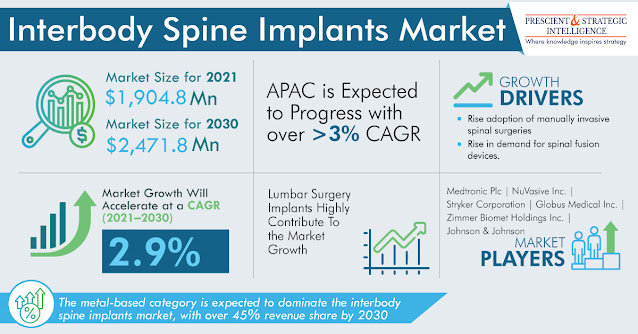In 2021, the global interbody spine implants market accounted for $1,904.8 million revenue, which is expected to touch $2,471.8 million by 2030, at a 2.9% CAGR. Advancements in spinal surgery technologies, increasing demand for spinal fusion devices owing to the rising prevalence of spinal ailments, fast acceptance of minimally invasive spine operations, and surging number of sophisticated bone-grafting product launches are the primary drivers for the market.
Market Opportunities
• Owing to the aging of the global population, there is a continuing demand for spinal implants, which drives spinal implant innovation. Metallic biomaterial implants, bioceramic implants, and polymeric implants have been developed for improved clinical results.
• Many companies offer products for advanced techniques, including oblique lateral interbody fusion (OLIF), robot-assisted spine surgery, and 3D printing, which offer several opportunities in the field of neurology drugs and surgeries.
In the coming years, metal-based implants are predicted to dominate the interbody spine implants market with more than 45% revenue share, growing at the highest rate. This might be because of the flexibility, robustness, and durability of these variants.
In the coming years, the APAC interbody spine implants market will advance with over 3.0% rate. India, China, Australia, South Korea, and Japan are the key revenue contributors to the market. This is due to the increasing awareness of spinal disorders and treatment options, a large patient pool, rising healthcare expenditure, and improving healthcare infrastructure.
North America dominates the interbody spine implants market owing to the deep penetration of spinal implants and a high volume of spinal fusion and non-fusion procedures. Furthermore, the regional industry is advancing due to the increasing incidence of spinal disorders, including disc herniation, spondylolisthesis, scoliosis, and spinal stenosis, as well as the increasing acceptance of advanced spinal implants in Canada and the U.S.
The interbody spine implants market of the APAC region will grow the fastest, with a growth rate of over 3.0%, by the end of this decade. Japan, India, China South Korea, and Australia contribute significantly to the regional market. This is because of the existence of a large patient population, a rise in consciousness of spinal disorders and treatment opportunities, enhancements in healthcare infrastructure, and an increase in healthcare spending. Furthermore, there is a presence of elderly population has a high risk of spinal ailments.




Comments
Post a Comment